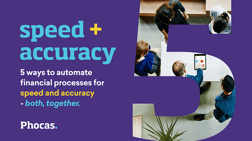How to overcome the C-suite’s new dilemma – speed vs accuracy

Now that organizations are restoring some semblance of pre-Covid normality, they find themselves mired in yet more economic and political uncertainty. Against this turmoil, agile forecasting, reporting, and speed are top of mind as CFOs seek to steer their organizations deftly through an unprecedented set of challenges.
It's a view supported by FSN's recent research which finds that speed of forecasting is of the essence. When asked which aspect of forecasting agility needs most improvement by 2030 a fulsome 86% of CFOs said the speed of the forecasting process.
This striking statistic reflects a new urgency and a palpable need for organizations to pivot more quickly in the face of constantly shifting markets. However, in their eagerness to ramp up the speed of these crucial processes, it is important that finance functions do not inadvertently overlook the importance of accuracy. The evidence so far is that forecasting accuracy has suffered. FSN’s 2021 research study, showed that only 43% of organizations could forecast revenue with +/-5% accuracy, and only 39% could achieve similar levels of forecasting accuracy for earnings.
So, the obvious question is how does the C-Suite resolve the speed versus accuracy trade-off?
Resolving the dilemma
CFOs agree that throwing more people at the problem isn’t necessarily the solution. FSN's 2022 survey identified that increasing headcount is low down the list of CFO priorities and even where headcount has been allowed to increase in one area, say, commercial accounting, there has been a commensurate decrease in another.
The answer appears to lie in relieving the constraints that many organizations face around data together with the technologies and skills needed to exploit it for a competitive edge. According to FSN’s 2022 research, only 20% of finance functions, (so-called “data masters”) claim that data is shared as a corporate asset and that they have the tools and resources needed to provide a competitive edge and insight. That leaves 80% who are either “data overloaded” (too many data sources and poor data governance), “data constrained” (they do not have the data they needed to drive insight and decision-making) or “technology constrained” (they do not have the tech-savvy resources and tools necessary to exploit the data they have).
With organizations facing so many data constraints, it is clear that any speed advantage will be short-lived, as doubts about data quality weigh heavily on the dependability, accuracy and trustworthiness of reporting.
A new generation of software tools
Well over 60% of mid-sized enterprises have an ERP or financial management system as the cornerstone of their information systems. In today’s increasingly complex data landscape, an ERP environment with its significant validation and controls baked-in, often represents the most robust and dependable source of data, provided it can be exploited appropriately.
Historically, finance and IT functions deployed a whole series of difficult-to-use BI (Business Intelligence) and reporting tools that required specialist knowledge to use, deploy and connect to underlying operational and ERP systems. But in recent years a new category of agile reporting tools has emerged that provide automatic connectors (interfaces) to popular ERP systems together with reporting capability that does not require specialised IT skills. Data quality may be a pressing issue, but it is not insurmountable.
This potent combination of automation and control helps to eliminate historic data quality problems and delays associated with complex data catalogues and dictionaries while at the same time accelerating the process of data capture and any upstream reporting and forecasting activities. With the whole of the finance function (and possibly other functions) sharing and exploiting the same data resource in real-time (one version of the truth), data mastery becomes a realistic prospect.
The answer to the speed vs accuracy dilemma
So, can CFOs have their ‘cake and eat it? Can they have increased reporting speed without compromising accuracy? The answer is unequivocally yes. All it takes is the right tools. Organizations that want to deliver increased accuracy and speed need to deploy modern reporting software that easily connects to operational, financial management and ERP systems and doesn’t require any specialised analytical skills to use.
A cloud-based budget planning solution to make your finance team more agile
Built using the latest technologies, Phocas Budgeting and Forecasting is a dynamic and user-friendly cloud-based solution that automates the manual budgeting process. All your data and reports are saved in the cloud, enabling you to securely access your financial budget plans and forecasts and seek feedback from area owners with a workflow-based financial budget approval process. The solution provides an intuitive Phocas interface, while retaining familiar spreadsheet formats to accelerate adoption. Get a demo today, or find out more about how to improve your financial agility by downloading the ebook 5 ways to automate financial processes below.

Using her 15 years+ experience as a CA, Jordena helps Phocas develop financial products that save time and provide ways to extend analysis and performance.

When to use an operating budget for more detailed planning
What is an operating budget? An operating budget is a resourceful tool that enables businesses to estimate income projections and expected expenses and plan for low-earning or high-spending months. This financial plan provides data that constantly records the costs of your business operations for a specific period (mainly up to the end of the year). It also serves as an outline detailing how much money a company spends and incurring expenses.
Read more
Best practices for cash flow forecasting
Whether you are managing inventory or planning an acquisition, to maintain day-to-day operations you need a clear cash flow forecasting process. Staying on top of cashflow means you can gauge your solvency and profitability from a long and short-term perspective.
Read more
Scenario analysis to manage risks and find opportunities for success
Scenario analysis effectively manages and prepares for possible outcomes by examining the potential impacts of future events and anticipating alternative scenarios, such as economic downturns or expanding a product line within a budget model.
Read more
How to improve cash flow in a manufacturing business
Manufacturers are responsible for ensuring an adequate supply chain for wholesalers, retailers, and, ultimately, the end user. When everything runs smoothly, a manufacturing business can be very profitable.
Read more
Find out how our platform gives you the visibility you need to get more done.
Get your demo today